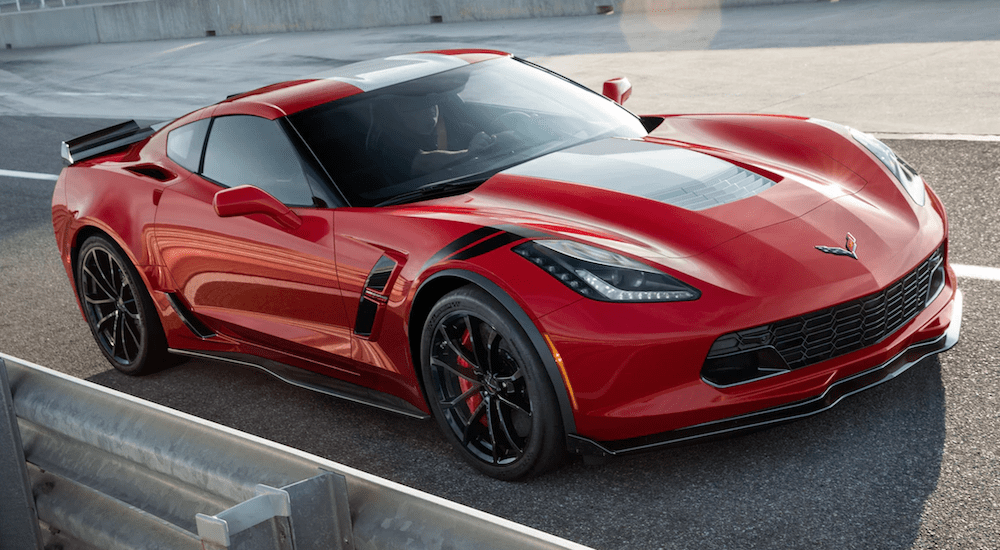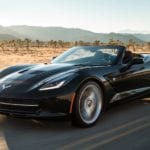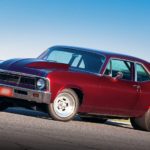The year is 1953. Dwight D. Eisenhower is inaugurated as President of the United States, the Korean War draws to a close, and the very first polio vaccine is developed. The Corvette appeared in the Motorama display at the New York Auto Show. After seeing how taken visitors were with the Corvette, GM developed a production version to be released to the public. With that, a legacy was born.
In conceptualization, and in name, the Corvette was transitive, representative of a changing post-war America with one door open to the past, and the other exiting to the future. Its name was derived from a diminutive and easily maneuverable warship, while it’s innovative design and engineering would both define American sports cars while redefining our collective romance with the open road.
For the past 65 years, Corvettes have been an icon of the American roadway and within American popular culture. Debuting on television on the iconic 1960’s program ‘Route 66’, the Corvette would go on to be called “the most successful concept car in history and the most popular sports car in history.” Lofty praise, indeed. And America’s favorite sports car would continue to enjoy a longstanding association with popular culture, featured in such beloved films as Animal House, Terms of Endearment, Austin Powers, Boogie Nights and (most recently) Fast Five, proving that Corvette’s driver-cred is still well intact.
And it was last year that the American icon celebrated its 65th anniversary, in the form of the 2018 Chevrolet Corvette. And now, with the eighth-generation, mid-engine C8 preparing to bolster Corvette’s existing ranks alongside the Z06 and ZR1 it has once again proven itself as a transitive wonder. So, with one door open to the future, let’s exit to the past and explore the storied history of this American icon.
“Project Opel”
During World War II, American soldiers who were stationed overseas were able to embrace the joy of driving the MG Sportscar. The two-door convertible embodied fun and, despite its diminutive stature, conveyed the singular love of driving. It was really no surprise that other British sports cars such as the Triumph TR and Jaguar XK120 would find a new niche in the American marketplace.
Enter Harley J. Earl, head of GM’s first in-house styling department. Collaborating with engineer Edward N. Cole and design engineer Robert F. McLean, Earl set out to develop a vehicle which reflected “his love of dramatic lines and styling details”. Intended for a 50/50 weight distribution, ‘Project Opel’ aimed for a cruising speed of 70-plus mph, with good handling, ample breaks and a weight-to-power ratio of better than 25 to 1. Designed to sit as low to the ground as possible, the vehicle would boast a roofline of only 47 inches and Earl would opt for fiberglass construction, deviating from the norm of steel with fiberglass exterior.
With design and construction out of the way, attention moved to the search for an engine. Earl opted to use a ‘Stovebolt Six’ 235.5ci Overhead-Valve Six-Cylinder, albeit with significant modifications. Those modifications would result in the birth of the ‘Blue Flame 150’ an engine configuration which complimented Earl’s concept in every way. And prior to the car’s debut at the 1953 Motorama show, Earl presented the completed vehicle to GM President Harlow Curtice and Chevy Division GM Thomas H. Keating. Enraptured with its enticing appearance (guaranteed to draw in buyers) and economy (profitable, after being built using existing equipment) Earl was given the approval to move the vehicle into production.
And, as mentioned above, the name ‘Corvette’ was selected based on the implication of speed, strength, maneuverability embodying every ounce of inspiration placed into the vehicle’s realization.
It only took six months for the first Corvettes to roll off the assembly line, making them eligible for 1953 model year status. Part of the reason this occurred so efficiently was the fact the final vehicle had changed very little from Earl’s original ‘Project Opel’ concept (a rarity, for sure).
C1: First Generation (1953-1962)
The C1 is the production model that GM built after the vehicle’s success at the New York Auto Show in 1953. Only 300 of these babies were made during the first model year, though that number increased tenfold the next year. They were initially priced at $3,498, which equates to approximately $32,000 in today’s dollars. Now, models from this year go for about ten times that price at auctions.
Originally, the C1 was only available in Polo White with a Sportsman Red interior, though the offerings expanded to include Pennant Blue, Sportsman Red, and Black in later years. The first models also came with a 150 horsepower straight-six engine and only included two luxury features, a heater and an AM radio.
From 1955 to the end of the first generation, the C1 received many upgrades and changes, including a new V8 engine, headlamps, exhaust tips, and steering wheel. The 1962 Corvette was the last to have the wrap-around windshield, convertible-only body, and a solid rear axle.
C2: Second Generation (1963-1967)
It was the second generation of Corvettes that introduced the Sting Ray coupe, which was smaller than the previous convertible-only models. The first big feature was the controversial split rear window, which only lasted for one model year but is prized by contemporary collectors. Hidden headlamps were a big marker on the C2, as were the four-wheel disc brakes, a 6.5L V8 engine, and an independent rear suspension. This big block engine got a more impressive 250 horsepower than the C1’s engine.
The C2 also introduced more luxury features, such as air conditioning, an updated radio, a telescopic steering wheel, and headrests. The price was listed at $4,252, more than $34,000 in today’s prices.
C3: Third Generation (1968-1982)
For more than a decade, the Corvette was mostly the same, including the Stingray, which was rebranded to be one word instead of two. It was also the same model to feature the T-top removable roof panels and the Chevy signifiers like ZR1, Z07, and LT1 that are still familiar with many people to this day. Some other notable features on the C3 were the 7.0L engine, standard theft-deterrent system, and an over-the-radiator, carburetor air-induction system.
During the 80s, the Corvette’s exterior was redesigned to be more aerodynamic, thus reducing drag. The C3 also featured several special editions, such as the Indy 500 Pace Car edition, the Silver Anniversary edition, and the Collector’s edition.
C4: Fourth Generation (1984-1996)
The C4 marked the first complete redesign of the Corvette since 1963. This model featured a standard LCD dashboard display and a six-speed manual transmission for models after 1989 to meet fuel economy standards. It initially got 205 horsepower and 290 lb-ft of torque, increasing to 230 horsepower after 1985, 240 in 1987, 300 in 1992, and 330 in 1996.
Though the price of the Corvette continued to increase over this period, sales actually fell for the Corvette, though the C4 still remained popular with collectors. For the 40th anniversary of the Corvette, there was a special Ruby Red edition that had anniversary badges and embroidered seat backs. This special edition Corvette got a whopping 405 horsepower.
However, it’s worth noting that the Corvette brand was struggling in the latter part of the 1980’s. In fact, it’s fair to say that General Motors, as a whole, were struggling to remain competitive amidst the onslaught of new offerings which were redefining the expectations of modern drivers. Unfortunately, the Corvette nameplate would find itself in the crosshairs during Chevy’s attempt to reprioritize their endeavors. Fortunately, Corvette had a champion in newly-appointed GM, Jim Perkins, who seemed determined to make sure that the best was yet to come.
C5: Fifth Generation (1997-2004)
The C5 improved upon many of the Corvette’s features and introduced new upgrades that are, in some cases, still included on today’s models. Some of the most important changes made to the C5 include a new body design, lowered weight, staggered tire size, twin fuel tanks, and the LS1 aluminum engine. It was originally only available in a coupe style, but a convertible style became available in 1998.
Introducing improved fuel economy, a larger trunk, and top speeds of 175 MPH, the C5 was touted as the most high-performing Corvette to date. Overall, an impressive achievement at a pivotal point in Corvette’s history.
C6: Sixth Generation (2005-2013)
Rather than completely redesigning the C6, Chevy refined the classic brand by focusing mainly on the interior features of the vehicle. The C6 introduced a larger, more sophisticated interior that was ultimately more comfortable for passengers. On the exterior, the C6 removed the pop-up headlamps. The engine was upgraded to a more powerful LS2 with 6.0L displacement, which made the vehicle more powerful with a whopping 400 horsepower output, but ultimately got worse gas mileage. The 2008 C6 received a new LS3 engine that was 6.2L and was paired with a six-speed manual transmission.
C7: Seventh Generation (2014-Present)
The 2018 Chevrolet Corvette delivers a thrilling ride within this precision sports car. The interior is geared towards the comfort of the driver, while the sculpted body of the exterior will increase the car’s aerodynamics and grab the attention of everyone around you. Available in 10 sleek colors, the 2018 Chevrolet Corvette gets a whopping 460 horsepower and 465 lb.-ft. of torque. And, if that’s not enough, the new Corvette can also go from zero to 60 in just 3.7 seconds.
It makes sense why the Corvette has been an icon of the American streets for the past 65 years. If you want to be a part of the Corvette’s long and storied history, visit your local dealership to test drive a 2018 Chevrolet Corvette today.
 C8: Eight Generation (2020-)
C8: Eight Generation (2020-)
At the time that this article is being written, it is expected that the mid-engine C8 will debut at the 2019 North American International Auto Show. That said, such exciting news contradicts earlier indication that the unveiling would be pushed to mid-2019, while some electrical ‘gremlins’ were being worked out of the system.
But whether we’ve had a look at the C8 by mid-January or mid-year is beside the point, there’s no getting around the fact that speculation has been running rampant for months. Even more interesting is the fact that (as true enthusiasts know) a mid-engine Corvette has been the stuff of rumor for nearly a half-century. In fact, a number of concepts have been built, only to be abandoned at some point during development.
Examples date back to 1970, where the concept was close to production-ready before being set aside. And initiating what can only be described as the start of a bizarre coincidence, the idea of a mid-engine Corvette would resurface sixteen years later in 1986 with the twin-turbo V8 Corvette Indy. Another sixteen years would bring us to 2002, where GM appeared to be dropping heavy anvils with their release of the Cadillac Cien concept, a 750 hp stunner equipped with a 7.5-liter V12 placed right behind the driver and passenger. The response would inspire the 2004 construction of clay models for another mid-engine Corvette, resulting from GM’s sense of fatigue with the front engine, RWD layout. This endeavor would, of course, be condemned to obscurity by the restraints of the global recession.
That said, the anticipation of the C8’s arrival is carried by the weight of lofty expectations. Its momentum comes from previous failings to see the mid-engine Corvette through, making its debut all the more riveting. For the performance-minded, it’s a paradigm shift in what it means for a supercar to bear the Corvette nameplate. And while we expect the price point to be palatable to a more modest segment of the enthusiast community, we have no doubt that it will be worth every penny.
In Memoriam
At the time this article is being written, it was revealed that Jim Perkins, former General Manager of Chevrolet had passed away at the age of 83. First employed by Chevrolet in 1960, the warehouse employee dedicated himself to the brand, elevating himself through continual promotions. After a brief departure to launch the Lexus brand in the U.S., Jim would return in 1989 having been appointed to the role of GM for the then-struggling brand. Criticized for falling behind in every area deemed important by the customer, Chevy was forced to prioritize their properties and with sales dropping to 20,000 units per year, Corvettes were the first to be targeted.
Ever faithful to the brand he loved, Perkins refused to bury the Corvette. Playing with finances, he was able to fund development of the C5 which would make its debut in 1997; and for the better part of a decade, sales of the C5 Corvette never dropped below the 32,000 mark. An impressive achievement, and one that undoubtedly shaped the history of the Corvette.

 C8: Eight Generation (2020-)
C8: Eight Generation (2020-)


